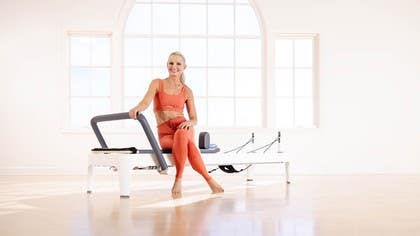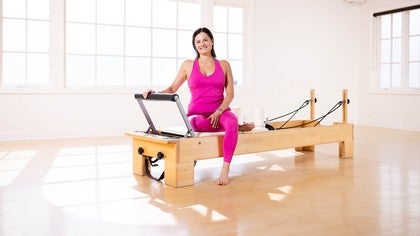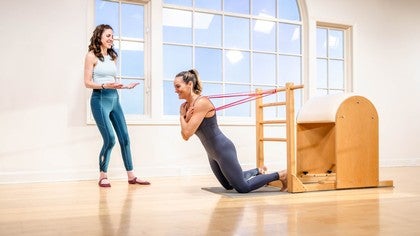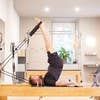Description
About This Video
Transcript
Read Full Transcript
Hello, everybody. Tracy Mallett here with Pilates anytime. I would love the opportunity to break down one of my flows that I use in my cardio reformer workout. I actually love this flow and use it a lot in my classes. Because it feels good.
It's challenging. Yes. I would say it's definitely intermediate advanced. But it just flows really well. So let's start on the side of the reformer. I usually put this at 1 spring.
I think that is ample for people to feel the resistance as we come up in our pike. Obviously, if you have a green spring for those who are little, want a little bit more extra challenge. You can always take it up to a green, or a red, and a u yellow, or a red, and a blue. But I am personally working at a red spring, which is one spring. So we first get into the position with this flying cat or flying our best love the word. I love calling it the flying cat and flying arabesque.
The hands are forwards. The arms are straight, and we start in a lunge position. If you cue that the back leg is fully extended, Always, it never bends. That is the game changer because it really because as people do it or as you do it, you can't tend to wanna bend your leg, but that leg stays strong and lengthened, plus the arms stay straight too. So there's no bending of the upper body.
So the arms are reaching out. Of course, we wanna slide the shoulder blades down. Feel the serratus. Feel the lats working here to stabilize the upper shoulder girdle. We bring in the carriage forwards.
Now what we can do to start with is just lifting that leg up so people can feel the abdominals lifting And then we can add a cat. So we're gonna go into our cat. So the knee comes to the chest. And as you can see, look, I'm rounding. So I'm gonna hold it there.
I'm gonna round it position, your spine is in a c curve position. Your pubic bone is drawing towards the belly button, and you're in that deep deep abdominal contraction here as you push away from your bar to reinitiate your shoulder girdle and get more intra abdominal pressure you lift up in that pike. So the arms must stay straight and you're using the momentum of the reformer to lift you up, which is why we love the reformer. So with first, we did the cat, which is here, and then I added a little external rotation. So this, I'm not cat Cating, isn't that funny? I'm not gonna cat the spine as much. I'm gonna keep the spine slightly an extension but externally rotate the knee diagonal to the side. So when I say diagonal to the side, that's my front, that is diagonal. So the knee is going diagonally out and externally rotated in the in the hip joint.
The femur is turning around but our spine stays extended. It's not so much in a cat. Love that word, catting. You're ready. We're gonna come back and see a lunge. So let's go, cat, and then external rotation.
And you can see my focus goes down to the reformer, and then it goes towards the knee. And then we go down and then turn out. So we're there. Still the knees off the reformer. The next flow is this leg that's on the floor is gonna cross inference of the stabilizing leg on the reformer.
So we're gonna lift up, pop it in front, and we're gonna go into, like, an upward stretch position here, draw your shoulders away from your ears. Now from here, we're gonna go into your plank, rotating around your shoulder joint. Now look at my back leg. I just Can you see that back foot is lengthening so I don't get jammed against the shoulder rest? And then I just bring it back into a pike.
Now when we're doing this, we are rotating around the shoulder joint. We come into a plank and we're reaching out through the crown of the head. We've got that laser beam reaching out through the crown of the head, and then we keep everything stable as we use the abs to come back. So a little bit more fluid is that back foot is lifting, and then it comes back down to hit the shoulder rest, inhale facilitates that lovely plank, and then exhale come back from here. We're gonna turn the back foot against the shoulder rest.
Your toes are pointing forwards, and that foot kinda stays where it is. And we open up into side plank. Here we go. Now for a lot of people, just holding here is going to be enough, and maybe you choose just to hold here in the workout. However, we can always take it to that next level and go into a little twist here as you're closing the carriage and then we come back out into your side plank. So it's a twist, close the carriage, And you're kind of rotating your torso, looking down in the direction that you're moving in, you gotta hit the stopper, and then you come back out again.
So it's really important that you move the carriage, hit the stopper, And if you think about it, look at your shoulder joint. You kinda keep in that shoulder joint super stable as we rotate around it lifting up through those obliques. Now we're gonna hold it here. Now your next transition is Take your hands back. Now the front leg, which is this front leg, is gonna rotate and step back to exactly where we started.
So I'm gonna go back again just so you can see that. So I'm here, right, or here. I rotate the hand and put that leg back down onto the floor. So I'm back in the position to now do the arabesque, which is definitely my favorite. Because now you can lengthen that leg, and this just basically gets your heart rate up work in your abs, work in your legs, you in that hip extension.
And if you want, you can always come up, do a little push up, and then bring it down, a little lift, little push up, and bring it down. There's always ways to make it more challenging And you know, I will always find those ways to make it a little bit more challenging. But I truly hope you like that flow because it moves You got elements of cardio in there, elements of core, a lot of shoulder stability, and a lot of core stability too. So if you have any questions, please let me know. I hope that clarifies is a little bit more for when you actually do the workout.
Or maybe if you're an instructor, you're gonna teach that work out. My classes actually loved it because it it felt fun for them. It was challenging, but they did it. So love to hear your comments, and I hope you like the new in Vogue class called Cating. Love that. Let me know what you think of Cating. Is that irrelevant? In the new Pilates industry.
I don't know, but thank you for joining me. I hope that clarifies and you enjoyed that flow. Take care. Bye bye.
Tips for Teachers: Keep It Fresh! Exercise Tutorials
Comments
You need to be a subscriber to post a comment.
Please Log In or Create an Account to start your free trial.













